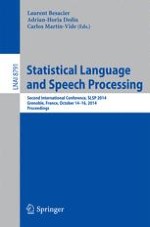2014 | OriginalPaper | Chapter
Structured GMM Based on Unsupervised Clustering for Recognizing Adult and Child Speech
Authors : Arseniy Gorin, Denis Jouvet
Published in: Statistical Language and Speech Processing
Publisher: Springer International Publishing
Activate our intelligent search to find suitable subject content or patents.
Select sections of text to find matching patents with Artificial Intelligence. powered by
Select sections of text to find additional relevant content using AI-assisted search. powered by
